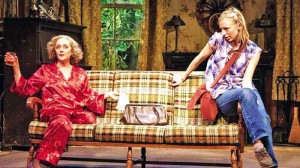Carol Kane channels Bette Davis in ‘The Lying Lesson’
Its predilection for boundless yarn-spinning keeps the theater industry exciting and dynamic. But, some of its ideas are as preposterous as they are whimsical.
This season, the most fascinating genre-benders on the New York stage include “Silence! The Musical,” Jon and Al Kaplan’s acclaimed “Silence of the Lambs” spoof, and Tim Flaherty’s “Cuff Me! The Fifty Shades of Grey Unauthorized Musical Parody,” which zanily sends up the raunchy antics of Christian Grey and Anastasia Steele.
In Craig Lucas’ fictional thriller, “The Lying Lesson” (staged at the intimate Linda Gross Theatre on 20th st. in Chelsea), the Pulitzer-nominated playwright imagines Bette Davis (Carol Kane) inhabiting his inventive two-hander—eight years before the eccentric actress succumbed to breast cancer in 1989. She was dubbed the Second Greatest Female Screen Legend of All Time (after Katharine Hepburn) by the American Film Institute.
Set during a stormy summer night in 1981, the 73-year-old screen icon (“All About Eve,” “Jezebel,” “Dangerous”) arrives unannounced in a shabby and deserted old house in a remote seaside village in Maine, where she grew up. She intends to buy it from the elderly couple who owns it.
In the twilight of her years, Davis dreams of rekindling her romance with the local dreamboat she was infatuated with as a teenager. The guy, now a widower, used to own the place. After four failed marriages, he just might be the answer to her heartbreaks!
Stellar identity
The actress’ reverie is cut short when she catches a stranger climb through the window. She then grabs a butcher’s knife and threatens to “sever your carotid artery!” The gangly, thirtysomething woman is Minnie Bodine (Mickey Sumner, Sting’s daughter), the caretaker of the rundown property, who seems oblivious to Davis’ stellar identity!
—But, something is amiss. Who is this overly enthusiastic woman who wants to work as her assistant? As the actress’ true identity unravels, she realizes that Minnie hasn’t exactly told her everything about herself!
The play keeps you guessing about the gist of its themes, but it’s weighed down by sluggish development, pretentious stylishness, and a shifty narrative that puts much of its focus on a dilemma that appears too trivial and inconsequential to deserve full-length build-up.
Director Pam MacKinnon, who won a Best Director Tony early this month (for “Who’s Afraid of Virginia Woolf?”), should have known that any substantial tale would require more than just bland niceties and episodic bursts of surprises—the stakes should consistently be high!
Screen royalty
If the production’s content proves slight and unsatisfying, greater pleasure can be derived from the spot-on characterization and nuanced portrayal of Carol Kane, who looks, walks and talks like the iconic screen royal. She delivers the actress’ quotable one-liners and dramatic monologues with aplomb—and elicits empathy when she recalls Davis’ triumphs and career missteps:
The two-time Oscar winner was elected as the first female president of the Academy of Motion Pictures and Sciences, but quit two months later because she said that the group merely wanted her to serve as a figurehead.
Davis’ snide remarks against Joan Crawford are part of movie lore: “Why am I so good at playing bitches? It’s because I’m not a bitch. Maybe that’s why Crawford always plays ladies!” “She’s slept with every male star at MGM—except Lassie!”
As Davis, Kane is a sight for sore eyes. She makes full use of her dramatic chops and comedic timing. With her character’s distinctive orbs lighting up the stage, she channels the actress’ sass and swagger, but manages to go beyond caricature—from the feisty quips to the scathing put-downs she reserves for colleagues who get on her bad side, like Crawford and actress Miriam Hopkins, whose husband, director Anatole Litvak, she had an affair with!
When Minnie asks Bette which character she portrayed in “What Ever Happened to Baby Jane?”—her hit 1962 starrer with Crawford (for which she was nominated for an Oscar)—she quickly replies, “I played the one who could act!” Ouch.
